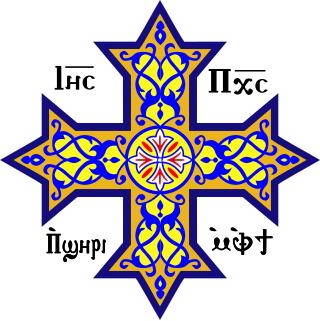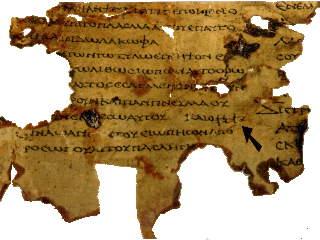Related Research Articles
In contrast to the variety of absolute or personal names of God in the Old Testament, the New Testament uses only two, according to the International Standard Bible Encyclopaedia. From the 20th century onwards, "a number of scholars find various evidence for the name [YHWH or related form] in the New Testament.

There have been many Coptic versions of the Bible, including some of the earliest translations into any language. Several different versions were made in the ancient world, with different editions of the Old and New Testament in five of the dialects of Coptic: Bohairic (northern), Fayyumic, Sahidic (southern), Akhmimic and Mesokemic (middle). Biblical books were translated from the Alexandrian Greek version.

The Oxyrhynchus Papyri are a group of manuscripts discovered during the late nineteenth and early twentieth centuries by papyrologists Bernard Pyne Grenfell and Arthur Surridge Hunt at an ancient rubbish dump near Oxyrhynchus in Egypt.

The Chester Beatty Biblical Papyri or simply the Chester Beatty Papyri are a group of early papyrus manuscripts of biblical texts. The manuscripts are in Greek and are of Christian origin. There are eleven manuscripts in the group, seven consisting of portions of Old Testament books, three consisting of portions of the New Testament, and one consisting of portions of the Book of Enoch and an unidentified Christian homily. Most are dated to the 3rd century CE. They are housed in part at the Chester Beatty Library in Dublin, Ireland, and in part at the University of Michigan, among a few other locations.

Papyrus 45, designated by siglum 𝔓45 in the Gregory-Aland numbering of New Testament manuscripts, is an early Greek New Testament manuscript written on papyrus, and is one of the manuscripts comprising the Chester Beatty Papyri, a group of early Christian manuscripts discovered in the 1930s, and purchased by business man and philanthropist, Alfred Chester Beatty. Beatty purchased the manuscript in the 1930s from an Egyptian book dealer, and it was subsequently published in The Chester Beatty Biblical Papyri, Descriptions and Texts of Twelve Manuscripts on Papyrus of the Greek Bible by palaeographer, biblical and classical scholar Frederic G. Kenyon in 1933. Manuscripts among the Chester Beatty Papyri have had several places of discovery associated with them, the most likely being the Faiyum in Egypt. Using the study of comparative writing styles (palaeography), it has been dated to the early 3rd century CE. This therefore makes it the earliest example of not only the four Gospels contained in one volume, but also the Acts of the Apostles. It contains verses in fragmentary form from the texts of Matthew chapters 20–21 and 25–26; Mark chapters 4–9 and 11–12; Luke chapters 6–7 and 9–14; John chapters 4–5 and 10–11; and Acts chapters 4–17.

The Tetragrammaton is the four-letter Hebrew theonym יהוה, the name of God in the Hebrew Bible. The four letters, written and read from right to left, are yodh, he, waw, and he. The name may be derived from a verb that means "to be", "to exist", "to cause to become", or "to come to pass". While there is no consensus about the structure and etymology of the name, the form Yahweh is now accepted almost universally among Biblical and Semitic linguistics scholars, though the vocalization Jehovah continues to have wide usage.

The earliest surviving manuscripts of the Septuagint, an ancient translation of the ancient Hebrew Torah into Koine Greek, include three 2nd century BCE fragments from the books of Leviticus and Deuteronomy and five 1st century BCE fragments of Genesis, Exodus, Leviticus, Numbers, and Deuteronomy, only. The vast majority of Septuagint manuscripts are late-antiquity and medieval manuscript versions of the Christian Greek Old Testament tradition.

Papyrus 47, designated by siglum 𝔓47, is an early Greek New Testament manuscript written on papyrus, and is one of the manuscripts comprising the Chester Beatty Papyri. Manuscripts among the Chester Beatty Papyri have had several places of discovery associated with them, the most likely being the Faiyum. Using the study of comparative writing styles (palaeography), it has been dated to the early 3rd century CE. The codex contains text from the Book of Revelation chapters 9 through 17. It is currently housed at the Chester Beatty Library in Dublin.

Robert A. Kraft was an American religious historian who was the Berg Professor of Religious Studies Emeritus at the University of Pennsylvania. He is known for his pioneering work in the application of computing to the study of ancient literature and for his significant contributions to the study of early Judaism and early Christianity. Kraft was president of the Society of Biblical Literature in 2006.

Papyrus Rylands 458 is a manuscript of the Pentateuch in the Greek Septuagint version of the Hebrew Bible. It is a roll made from papyrus, which has survived in a very fragmentary condition. It is designated by the number 957 on the list of Septuagint manuscripts according to the numbering system devised by biblical scholar Alfred Rahlfs. Using the study of comparative writing styles (palaeography), the manuscript has been dated to the middle of the 2nd century BCE.

The Papyrus Fouad 266 are fragments, part of a papyrus manuscript in scroll form containing the Greek translation, known as the Septuagint, of the Pentateuch. They have been assigned palaeographically to the 1st century BCE. There is discussion about whether the text is original or a later recension of the Septuagint.

Papyrus 967 is a 3rd-century CE biblical manuscript, discovered in 1931. It is notable for containing fragments of the original Septuagint text of the Book of Daniel, which was completely superseded by a revised text by the end of the 4th century and elsewhere survives only in Syriac translation and in Codex Chisianus 88. The manuscript is also important for early variants, both in the text of the Book of Ezekiel and of the Book of Daniel.

Papyrus Oxyrhynchus 1007 is a fragment of a Greek Septuagint manuscript written on parchment. The manuscript was discovered in Oxyrhynchus, modern El-Bahnasa, Egypt. Using the study of comparative writing styles (palaeography), the manuscript has been dated to the 3rd century CE.
The Papyrus Vindobonensis Graecus 39777 signed as SymP.Vindob.G.39777 – is a fragment of a Greek manuscript of the Psalms of the translation of Symmachus. It was written in papyrus in a scroll form. The papyrus contains fragments of Psalm 69 and Psalm 81. The P.Vindob.G.39777 is dated to late third century or beginning fourth century AD.

The Papyrus LXX Oxyrhynchus 3522, – is a small fragment of the Greek Septuagint (LXX) written in papyrus, in scroll form. As one of the manuscripts discovered at Oxyrhynchus it has been catalogued with the number 3522. Palaeographically it has been dated to the 1st century CE. The text agrees with the LXX.

Papyrus Oxyrhynchus 5101, designated by 2227, or P.Oxy.77 (LXXVII) 5101, is a manuscript of the Greek Septuagint Psalms, written on papyrus in roll form. It has survived in a very fragmentary condition. Using the study of comparative writings styles (palaeography), it has been dated to the middle of the first - middle of the second century CE.
Papyrus Oxyrhynchus 4443 is a fragment of a Septuagint manuscript (LXX) written on papyrus in scroll form. It is the oldest extant manuscript that contains Esther 8:16–9:3 of the Septuagint text and verse numbering, according to the text of LXX. The manuscript has been assigned palaeographically to 50–150 CE.
AlbertPietersma is Dutch professor emeritus of Septuagint and Hellenistic Greek in the Department of Near and Middle East Civilizations at the University of Toronto‘s Faculty of Arts and Science.

The Papyrus Chester Beatty VI are fragments of a papyrus manuscript of the Greek Septuagint and one of the Chester Beatty papyri. It contains parts of the Book of Numbers and Deuteronomy. Using the study of comparative writing styles (palaeography), it has been dated to 200 CE.
References
- 1 2 Edgar, David Hutchinson (2018). "Chapter 15. The Chester Beatty Biblical Collection: A Treasury of Early Christian Manuscripts in an Irish Library". In Anderson, Bradford A.; Kearney, Jonathan (eds.). Ireland and the Reception of the Bible: Social and Cultural Perspectives. The Library of Hebrew Bible/Old Testament Studies / Scriptural Traces. Bloomsbury Publishing. ISBN 9780567678881.
- 1 2 Kenyon, Frederic G. (1936). "Fasciculos IV. Genesis (Pap. V) A". The Chester Beatty Biblical Papyri. Descriptions and Texts of Twelve Manuscripts on Papyrus of the Greek Bible (PDF). London: Emery Walker Limited. p. 3.
- ↑ Mugridge 2016, pp. 162.